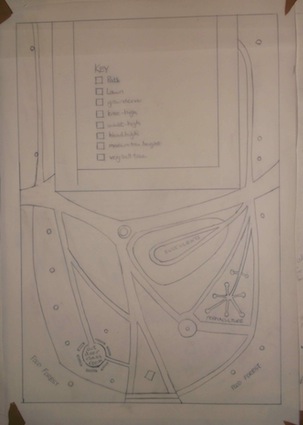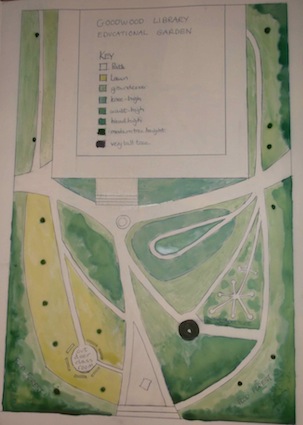Dear Reader, in this age of AI created content, please support with your goodwill someone who works harder to provide the human-made. Sign up at the top of the lefthand column or bottom of this page. You will receive my hand illustrated monthly newsletter RESTORE NATURE and access to the biodiversity garden design course as I write...and nothing else, I respect your time. I am also removing the advertizing as best I can as its become intrusive inappropriate and pays me nothing.
the library gardens in goodwood

About six months ago strolling through the Goodwood Library Gardens I noted they seemed a bit neglected and spoke to the head librarian about taking it on as a project. She said that the garden was a problem as state funding had been severely cut back and they could not afford any of the projects which had been tendered thus far.
The Friends of Goodwood Library, which is quite an active group showed a lot of interest in taking over the garden, but that an attempt at starting community management of the garden had not made progress. I decided to start a design for this space. Yvandro Reynolds from TUFCO (urban farming project) came to take a look and give me some advice. He recommended I produce a proposal that involved a drawn up visual plan.

outline of the library gardens design
The Goodwood library gardens are very spacious and surrounded by a galvanized steel fence. The aim of my design will be to give local young people living in Goodwood who pass through the library in a constant stream, a green education in the garden itself. This would be focussed on green politics and opportunities in the green industries for teenagers and young people. They say the next industrial revolution will be in the green industries, for example in things like the massive technological advance and mechanization of green roofing found in Germany, and that it has become mandatory for large buildings in France. South Africa is sorely lacking in knowledge of such entrepreneurial potentials. There is money to be made when these changes arrive in South Africa and the benefits of green roofing, as an example, are extraordinarily wide reaching and pertinent to us. For the younger kids there will be fun in the garden with biology and making up plays, and for the retirees for whom I have a heart and are also ‘young people’ at heart, workshops on permaculture, indigenous food lore, and more.
This educational garden I’m planning is geared at helping the library, by solving one of the library's problems, children who are dropped off and without supervision, create a disturbance in the library. So in the library gardens there will be an outdoor classroom where the naughty kids can perform and move about and compete in rap battles and be given educational green projects to work on, with volunteer teachers. Goodwood has a very mixed population, counting many religions, and vibrant religious communities, and a lot of children of refugees, for example from the DRC Congo, who need to be made to feel at home and to be part of activism in South Africa. On the other hand, many mothers with hyperactive children cannot afford the extra afternoon care, and burdened and burned out, they drop their children at the library, where they make it impossible for the other children and the adults to work. Being ADD myself I feel the hyperactive children causing trouble are probably very creative, and smart, with a need for hands-on learning and to express themselves in physical activity.
Not all the librarians are persuaded, but I hope in time that
the project will be realised. In the meantime I'm working on resolving a low
impact, zero cost design project incorporating all existing elements, low
maintenance and cost free materials, which can be added incrementally
as plant donations come in. It will include a nursery to
provide free starter plant material to the Goodwood library gardens, and later to other libraries and or schools in Cape
Town who co-operate in the project, so that the possibility exists that they
can be developed similarly, using our existing skills base. The parts of the
garden will be an outdoor classroom, a nursery, a worm compostery, a three
sisters garden in which the history of agriculture shows the permacultural
wisdom of the past, in the native American pattern of planting cucurbits, maize
and pulses together. I’d add some Solanaceae to complete the picture of the
Amerindian inheritance in today’s foods. There will be a permaculture garden with
traditional vegetables and herbs to tie into the deep history of market gardens
in the neighbourhood, an indigenous edibles patch, to link back to the rich
heritage of Khoekhoe plant lore, a food forest, a patch of Strandveld Fynbos to
show children what kind of plants dominated here before the area was farmed, an
indigenous medicinal and perfume garden, a decorative shady plants garden for
Clivias and such, and a calming shaded walkway under the trees to the outdoor
classroom for children and adult's green workshops. Anyone who can give a green
workshop free of cost please contact me at physalis5000@yahoo.de.
The garden in totality is planned for waterwise planting and low maintenance levels, and for a maxiumum level of indigneity, historical relevance, plant usability and educative worth. There will be small information signs, as many as we can afford.
Each section of the garden is designed with the expert knowledge of a contact person of mine in mind, from the permaculture network in Cape Town, to township gardening projects, growers of indigenous edibles, urban farmers with knowledge of how to establish food forests, and the two collectors of succulents I have met in Goodwood, one of whom is interested in community management of the garden, and the other who can donate plant material. I hope to get some plant donations for the Strandveld and Medicinal sections either from Kirstenbosch or the local indigenous nursery, Granny’s Green, and will do what I can to get hold of material for propagating indigenous edibles. It remains to find contributors who can give the garden trees and vines for the food forest: olives, peaches, almonds, apples, lemons, kiwis, grapes, grenadillas, Cape gooseberry, brambles and blackberries, strawberries, tomatoe trees, persimons would all be welcome.
I think the main problem with the garden is going to be finding the plant material, especially full grown trees, which would amount to tens of thousands if bought commercially, and the teachers to keep a constant program going for environmental education. The laying out itself is planned in such small steps and increments, and I know how to use recycled materials to good effect, so that with some co-operation from the Goodwood Library friends it should not be a problem, even if it takes a few years to accomplish.
Please see my photoalbum of the library garden and the design development at my website edenfound.weebly.com.

the outline of the library gardens colour coded for height as i'm working on sightlines
home page for more green inspirations
Restore Nature Newsletter
I've been writing for four years now and I would love to hear from you
Please let me know if you have any questions, comments or stories to share on gardening, permaculture, regenerative agriculture, food forests, natural gardening, do nothing gardening, observations about pests and diseases, foraging, dealing with and using weeds constructively, composting and going offgrid.
SEARCH
Order the Kindle E-book for the SPECIAL PRICE of only
Prices valid till 30.09.2023
Recent Articles
-
garden for life is a blog about saving the earth one garden at a time
Apr 18, 25 01:18 PM
The garden for life blog has short articles on gardening for biodiversity with native plants and regenerating soil for climate amelioration and nutritious food -
Cape Flats Sand Fynbos, Cape Town's most endangered native vegetation!
Apr 18, 25 10:36 AM
Cape Flats Sand Fynbos, a vegetation type found in the super diverse Cape Fynbos region is threatened by Cape Town's urban development and invasive alien plants -
Geography Research Task
Jan 31, 25 11:37 PM
To whom it may concern My name is Tanyaradzwa Madziwa and I am a matric student at Springfield Convent School. As part of our geography syllabus for this
"How to start a profitable worm business on a shoestring budget
Order a printed copy from "Amazon" at the SPECIAL PRICE of only
or a digital version from the "Kindle" store at the SPECIAL PRICE of only
Prices valid till 30.09.2023







